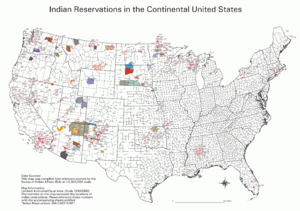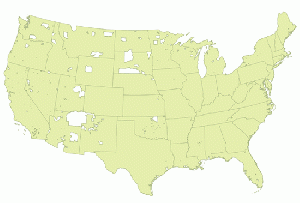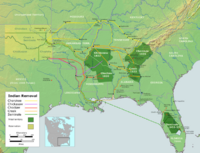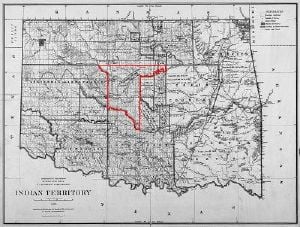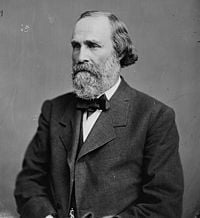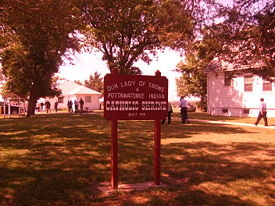Indian reservation
An Indian reservation in the United States is an area of land managed by a Native American tribe under the United States Department of the Interior Bureau of Indian Affairs. There are more than 300 Indian reservations in the United States, all established either by treaty or decree.
Indian removal was a policy pursued intermittently by American presidents early in the nineteenth century, but more aggressively pursued by President Andrew Jackson after the passage of the Indian Removal Act of 1830. The act led to the creation of Indian territory, the general borders of which were set by the Indian Intercourse Act of 1834. Eventually, the Indian Appropriations Act of 1851 authorized the establishment of legally recognized reservations in the U.S. While in the twenty-first century reservation travel is unrestricted, at the time of establishment indigenous residents were forbidden from traveling outside the reservation boundaries.
The Dawes Act of 1887, also known as the General Allotment Act, ended the general policy of granting land parcels to tribes as-a-whole by granting small parcels of land to individual tribe members. This system of fragmentation rendered much of reservation land unusable and had a catastrophic effect upon native culture, forcing the move from a clan system to a family system and imposing a patrilineal nuclear household onto many traditional matrilineal Native societies. The Indian Reorganization Act of 1934 reversed the Dawes Act's privatization of common holdings of Indian lands and supported the return to local self-government on a tribal basis.
In 1983, President Ronald Reagan issued a policy statement which reaffirmed the government-to-government relationship of Indian tribes with the United States; expressed the primary role of tribal governments in reservation affairs; and called for special efforts to develop reservation economies.
Most reservations have suffered high rates of poverty, unemployment, and substance abuse. However in recent years they have come to represent an oasis of tribal and cultural identity, providing a base of support for the expansion of Native American rights. While the history of this system has been tragic, the Indian reservation has protected the indigenous peoples from complete assimilation and loss of identity.
Historical background

In order to more fully understand the process through which Native Americans were "placed" in designated lands known as reservations, it is necessary to understand the broader scope of the fledgling United States.
Continental expansion usually meant the occupation of Native American land. The U.S. continued the European practice of recognizing only limited land rights of indigenous peoples. In a policy formulated largely by Henry Knox, Secretary of War in the Washington Administration, the U.S. government initially sought to expand into the west only through the legal purchase of Native American land in treaties. Indians were encouraged to sell their vast tribal lands and become "civilized," which necessitated (among other things) Native American men to abandon hunting and become farmers, and for their society to reorganize around the family unit rather than the clan or tribe.
While Thomas Jefferson believed that American Indians were the intellectual equals of whites, he also believed it necessary that they learn to live like the settlers or inevitably be pushed aside by them. Jefferson's beliefs, rooted in Age of Enlightenment thinking, which held that settlers and Native Americans would merge to create a single nation, did not survive his lifetime. Jefferson grew to believe that the natives should emigrate across the Mississippi River and maintain a separate society, an idea formulated and made possible by the Louisiana Purchase of 1803.
First land acquisitions
As the new nation expanded westward, the U.S. government's initial means of acquiring land was through a treaty-purchase process. There were various reasons the tribes agreed to signing treaties, which in most cases they could not read, and whose translations were often lacking. In numerous cases, government representatives procured the signatures of those not authorized to speak for the tribes, yet required them, to obey the conditions of the ill-begotten agreements. In other cases, tribes agreed to treaties in order to appease the government in the hopes of retaining some of their land, and to avoid conflicts with settlers. The signing of a treaty often followed a resignation of defeat and served as a last resort effort to bring peace.
Prior to the American Revolution, various colonies created unofficial reservations, some of which were later formally recognized as "Indian reservations." The first such reserve in North America was established on August 1, 1758, in Burlington County New Jersey by the New Jersey Colonial Assembly, and was designated a "permanent home" for the Lenni-Lenape tribe.
While the government initially sought to secure Native lands through treaty-purchase, eventually additional means were employed, such as "discovery," right of conquest, coercion, and military force. In 1823 the Supreme Court handed down a decision (Johnson v. M'Intosh), which stated that Indians could occupy lands within the United States, but could not hold title to those lands. This was because their "right of occupancy" was subordinate to the United States' "right of discovery."[1]
Creation of Indian agencies
In 1775 a trio of Indian agencies were created by the Second Continental Congress. Benjamin Franklin and Patrick Henry were among the early commissioners, who were charged with negotiating treaties with Native Americans and obtaining their neutrality during the American Revolutionary War. In 1789, the United States Congress placed Native American relations within the newly-formed War Department.
By 1806, the Congress had created a Superintendent of Indian Trade within the War Department who was charged with maintaining the factory trading network of the fur trade. The post was held by Thomas L. McKenney from 1816 until the abolition of the factory system in 1822. In 1824 the Office of Indian Affairs (now known as the Bureau of Indian Affairs) was formed. In 1832, Congress established the position of Commissioner of Indian Affairs. In 1869, Ely Samuel Parker became the first commissioner of Indian affairs who was himself an Indian.
The Indian Removal Act
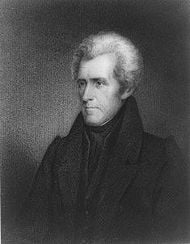
Indian resistance to voluntary removal and a decreasing willingness to sell land via treaty led to the Indian Removal Act, part of a government policy known as Indian removal, which was signed into law by President Andrew Jackson on May 26, 1830.[2]
The Removal Act was strongly supported in the South, where states were eager to gain access to lands inhabited by the "Five Civilized Tribes" (the Cherokee, Chickasaw, Choctaw, Creek, and Seminole) In particular, Georgia was involved in a contentious jurisdictional dispute with the Cherokee nation. President Jackson hoped removal would resolve the Georgia crisis.
The Indian Removal Act met with great controversy. Indian removal was in theory intended to be voluntary, in practice great pressure was put on Indian leaders to sign removal treaties. Most observers, whether they were in favor of the Indian removal policy or not, realized that the passage of the act meant the inevitable removal of most Indians from the eastern states. After Jackson's landslide reelection in 1832, some Native American leaders who had previously resisted removal eventually began to reconsider their positions.
While many Americans favored the passage of the Indian Removal Act, there was significant opposition. Many Christian missionaries, most notably missionary organizer Jeremiah Evarts, agitated against passage of the Act. In Congress, New Jersey Senator Theodore Frelinghuysen and Congressman David Crockett of Tennessee spoke out against the legislation. Despite these efforts the Removal Act was passed following bitter debate in Congress.
The Removal Act paved the way for the reluctant, and often forcible, emigration of tens of thousands of American Indians to the West. The first removal treaty signed after the Removal Act was the Treaty of Dancing Rabbit Creek on September 27, 1830 which Choctaws in Mississippi ceded land east of the river in exchange for payment and land in the West. The Treaty of New Echota, signed in 1835, resulted in the removal of the Cherokee via the Trail of Tears. The Seminoles did not leave peacefully as did other tribes; along with fugitive slaves they resisted the removal. The Second Seminole War from 1835 to 1842 resulted in the forced removal of Seminoles. Nearly 3,000 Seminole were killed resisting.[3] Only a small group of Seminole "renegades" remain on or near their traditional lands. Other treaties with dozens of other tribes resulted in their placement on lands often far from their homes and requiring treks of hundreds of miles.
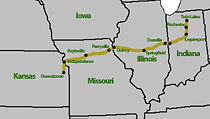 Potawatomi Trail of Death route, 1838. |
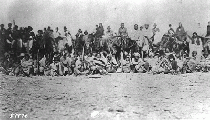 Navajo on the Long Walk to Bosque Redondo, 1864. |
The Indian Appropriations Acts
1851 Act
In 1851, the United States Congress passed the Indian Appropriations Act which authorized the creation of Indian reservations in modern day Oklahoma. Relations between settlers and natives had grown increasingly worse as the settlers encroached on territory and natural resources in the West.
President Ulysses S. Grant pursued a stated "Peace Policy" as a possible solution to the conflict. The policy included a reorganization of the Indian Service, with the goal of relocating various tribes from their ancestral homes to parcels of lands established specifically for their inhabitation. The policy called for the replacement of government officials by religious men, nominated by churches, to oversee the Indian agencies on reservations in order to teach Christianity to the native tribes.
In many cases the lands granted to tribes were hostile to agricultural cultivation, leaving many tribes who accepted the policy in a state bordering on starvation.
Reservation treaties sometimes included stipend agreements, in which the federal government promised to grant a certain amount of goods to a tribe yearly. The implementation of the policy was erratic, however, and in many cases the stipend goods were not delivered.
Controversy
The policy was controversial from the start. Reservations were generally established by executive order. In many cases, settlers objected to the size of land parcels, which were subsequently reduced. A report submitted to Congress in 1868 found widespread corruption among the federal Indian agencies and generally poor conditions among the relocated tribes.
Many tribes ignored the relocation orders at first and were forced onto their new limited land parcels. Enforcement of the policy required the United States Army to restrict the movements of various tribes. The pursuit of tribes in order to force them back onto reservations led to a number of Indian Wars. The most well known conflict was the Sioux War on the northern Great Plains, between 1876 and 1881, which included the Battle of the Little Bighorn. Other famous wars in this regard included the Nez Perce War.
By the late 1870s, the policy established by President Grant was regarded as a failure, primarily because it had resulted in some of the bloodiest wars between Native Americans and the United States. By 1877, President Rutherford B. Hayes began phasing out the policy, and by 1882 all religious organizations had relinquished their authority to the federal Indian agency.
1885 Act
In 1879 Elias C. Boudinot began a campaign to open the land "unoccupied by any Indian" to settlement by non-Indians. He pointed out in a letter published in 1879 that four of the Five Civilized Tribes, unlike the Cherokee, had extinguished their complete title to the lands ceded following the Civil War and received full payment. He put forth the view that that area had thus become Public Land and suggested the names Unassigned Lands and Oklahoma for the district.
In an attempt to prevent encroachment, President Rutherford B. Hayes issued a proclamation on April 26, 1879, forbidding trespass into the area, "…which Territory is designated, organized, and described by treaties and laws of the United States and by executive authorities as the Indian's country…." His proclamation had little effect; almost immediately following Boudinot's letter, speculators and landless citizens began organizing and agitating for the opening of the land to settlement. The newspapers generally referred to these pro-settlement forces as Boomers and followed Boudinot's lead in referring to the area as the Unassigned Lands or Oklahoma.
The Boomers planned excursions, which they called raids, into the area and surveyed town sites, built homes, and planted crops. The United States sent troops to round them up and expel them. The Boomer raids continued for several years. In 1885, Congress passed a new Indian Appropriations Act which allowed Indian tribes to sell unoccupied lands in their possession.
1889 Act
After years of trying to open Indian Territory, President Grover Cleveland, authorized a new Indian Appropriations Act on March 2, 1889, which officially opened the Unassigned Lands to settlers via homestead. Cleveland signed the Act into law days before his successor, Benjamin Harrison, took over as President of the United States.
This led to what became known as the Oklahoma Land Run of 1889, as the previously restricted land was opened for homesteading on a first arrival basis.
The Dawes Act
On February 8, 1887, Congress undertook a significant change in reservation policy by the passage of the Dawes Act, named after its sponsor, U.S. Senator Henry L. Dawes of Massachusetts. Also known as the General Allotment Act (GAA), it ended the general policy of granting land parcels to tribes as a whole by granting small parcels of land to individual tribe members. In some cases, for example the Umatilla Indian Reservation, after the individual parcels were granted out of reservation land, the reservation area was reduced by giving the excess land to settlers. The act was amended in 1891 and again in 1906 by the Burke Act. The individual allotment policy continued until 1934, when it was terminated by the Indian Reorganization Act.
Effects
The land granted to most was not sufficient for economic viability, and division of land between heirs upon inheritance resulted in land fractionation. Most allotment land, which could be sold after a statutory period of 25 years, was eventually sold to non-Native buyers at bargain prices. Additionally, land deemed to be "surplus" beyond what was needed for allotment was opened to settlers. The profits from the sales of these lands were often invested in programs purported to aid the American Indians. Native Americans lost, over the 47 years of the Act's life, about 90 million acres (360,000 km²) of treaty land, or about two-thirds of the 1887 land base. The result was that almost 90,000 Indians were made landless.[4]
The Dawes Act, with its emphasis on individual land ownership, had a negative impact on the unity, self-government, and culture of Indian tribes.[4] By dividing reservation lands into privately-owned parcels, the communal life-style of the Native societies was abruptly changed into a nuclear family system. Cultural values and economic dependency, previously on the tribal level, fell strictly within this small household unit.[5]
The allotment policy depleted the land base and ended hunting as a means of subsistence. The males were then forced out of their traditional hunter role into the fields—previously the woman's role as gatherer—and the women were domesticated. Thus this Act imposed a patrilineal nuclear household onto many traditional matrilineal Native societies. No longer were the traditional roles of hunter gatherer viable pursuits.
In 1906 the Burke Act (also known as the Forced Patenting Act) further amended the GAA to give the Secretary of the Interior the power to issue a patent in fee simple to people classified "competent and capable." The criteria for this determination is unclear but meant that those deemed "competent" by the Secretary of the Interior would have their land taken out of trust status, subject to taxation, and could then be sold by the person to whom it was allotted. The allotted lands of Indians determined to be incompetent by the Secretary of the Interior were automatically leased out by the Federal Government.[6] The use of competence opened up categorization, and made allotment of land much more subjective and thus increased the exclusionary power of the Secretary of Interior. Although this act gave power to the allottee to decide whether to keep or sell the land, the harsh economic reality of the time, lack of access to credit and markets, liquidation of Indian lands was almost inevitable. As above, it was known by the Department of Interior that virtually 95 percent of fee patented land would eventually be sold.[7]
Analysis of the Act
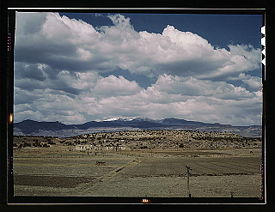
In 1926, Secretary of the Interior Hubert Work commissioned a study of federal administration of Indian policy and the condition of Indian people. The Problem of Indian Administration – commonly known as the Meriam Report after the study's director, Lewis Meriam—documented years of fraud and misappropriation by government agents. In particular, the Meriam Report found that the General Allotment Act had been used almost since its inception to illegally deprive Native Americans of their land rights.[8] After considerable debate, the United States Congress in 1934 terminated the allotment process under the Dawes Act by enacting the Indian Reorganization Act ("Wheeler-Howard Act"). (However, the allotment process in Alaska under the separate Alaska Native Allotment Act continued until its revocation in 1993 by the Alaska Native Claims Settlement Act.)
Despite termination of the allotment process in 1934, effects of the General Allotment Act continue. For example, one provision of the Act was the establishment of a trust fund, administered by the Bureau of Indian Affairs, to collect and distribute revenues from oil, mineral, timber, farming, and grazing leases on Native American lands. The BIA's alleged improper management of the trust fund resulted in litigation, in particular the ongoing case Cobell v. Kempthorne, to force a proper accounting of revenues.
Angie Debo's landmark work, And Still the Waters Run: The Betrayal of the Five Civilized Tribes (completed 1936, published 1940), detailed how the allotment policy of the Dawes Act (as later extended to apply to the Five Civilized Tribes through such devices as the Dawes Commission and the Curtis Act of 1898) was systematically manipulated to deprive the Native Americans of their lands and resources.[9] Historian Ellen Fitzpatrick described Debo's book as having, "advanced a crushing analysis of the corruption, moral depravity, and criminal activity that underlay white administration and execution of the allotment policy."[10]
The "Indian New Deal"
The administration of President Herbert Hoover reorganized the Bureau of Indian Affairs and also provided it with major funding increases. However, lasting reform of federal Indian policy did not occur until the election of Franklin D. Roosevelt in 1932 and the introduction of his New Deal policies.
As a reform-minded president, Roosevelt nominated John Collier as Commissioner of Indian Affairs in 1933. To alleviate the conditions brought on by the Great Depression, Collier set up the Indian Civilian Conservation Corps. The Corps provided jobs to Native Americans in soil erosion control, forestation, range development, and other public works projects. Coinciding with Roosevelt's New Deal, Collier introduced the Indian New Deal with the passing of the Indian Reorganization Act of 1934 which became one of the most influential and lasting pieces of legislation relating to federal Indian policy. Also known as the Wheeler-Howard Act, this legislation reversed fifty years of assimilation policies by emphasizing Indian self-determination and a return of communal Indian land which was in direct contrast with the objectives of the Indian General Allotment Act of 1887.
Collier was also responsible for getting the Johnson-O'Malley Act passed which allowed the United States Secretary of the Interior to sign contracts with state governments in an effort to share responsibility for the social and economic well-being of American Indians.
The Indian Reorganization Act
The Indian Reorganization Act of June 18, 1934, also known as the Wheeler-Howard Act or informally, the Indian New Deal, was a U.S. federal legislation which secured certain rights to Native Americans, including Alaska Natives.[11] These included a reversal of the Dawes Act's privatization of common holdings of American Indians and a return to local self-government on a tribal basis. The Act also restored to Native Americans the management of their assets (being mainly land) and included provisions intended to create a sound economic foundation for the inhabitants of Indian reservations. Section 18 of the IRA conditions application of the IRA on a majority vote of the affected Indian nation or tribe within one year of the effective date of the act (25 U.S.C. 478). The IRA was perhaps the most significant initiative of John Collier Sr., a social reformer and Indian advocate who was Commissioner of the Bureau of Indian Affairs from 1933 to 1945.
The act did not require tribes to adopt a constitution. However, if the tribe chose to do so, the constitution had to:
- Allow the tribal council to employ legal counsel
- Prohibit the tribal council from engaging any land transitions without majority approval of the tribe
- Authorize the tribal council to negotiate with the Federal, State, and local governments
The act slowed the practice of assigning tribal lands to individual tribal members and reduced the loss, through the practice of checkerboard land sales to non-members within tribal areas, of native holdings. Owing to this Act and to other actions of federal courts and the government, over two million acres (8,000 km²) of land were returned to various tribes in the first 20 years after passage of the act.
The Indian termination policy
The Indian termination policy was set by the United States Congress in the 1950s and 1960s to assimilate the Native Americans into mainstream American society. The intention was to terminate the U.S. government's trusteeship of Indian reservations and induce Native Americans to assume all responsibilities of full citizenship.
Congress passed termination acts on a tribe by tribe basis, but most included the end of federal recognition and all the federal aid that came along with being federally recognized tribes. The government terminated its recognition of a total of 109 tribes and bands as sovereign dependent nations. Their population totaled over 11,000 Indians or 3 percent of the total Indian population.[12]
In 1961, President John F. Kennedy decided against implementing any further termination measures, although he did enact some of the last terminations, including that of the Ponca Tribe, which culminated in 1966. Presidents Lyndon B. Johnson and Richard Nixon decided to encourage Indian self-determination rather than termination.
Some tribes resisted the policy by filing civil lawsuits. The litigation lasted until 1980, when the issue made its way to the US Supreme Court. The 1974 Boldt Decision was upheld in 1980 to recognize those treaty rights that were lost. With problems arising in the 1960s several organizations were formed, such as the American Indian Movement (AIM) and other organizations that sought to protect the rights of the Indians and their land.[13]
In 1975, Congress had implicitly rejected the termination policy by passing the Indian Self-Determination and Education Assistance Act, which increased the tribal control over reservations and helped with the funding of building schools closer to the reservations. On January 24, 1983, President Ronald Reagan issued an American Indian policy statement that supported explicit repudiation of the termination policy and which reaffirmed the government-to-government relationship of Indian tribes with the United States; expressed the primary role of tribal governments in reservation affairs; and called for special efforts to develop reservation economies. The President’s policy expanded and developed the 1970 national Indian policy of self-determination for Indian tribes.[14]
Twenty first century
Today there are about 310 Indian reservations in the United States, with a collective geographical area of 52.7 million acres (82,343.75 mi²)[15], representing 2.21 percent of the area of the United States (2,379,400,204 acres; 3,717,812.82 mi²). Not all of the country's 562 recognized tribes[15] have a reservation—some tribes have more than one reservation, others have none. In addition, because of past land sales and allotments, most reservations are severely fragmented to the point of being non-usable. Each piece of tribal, trust, and privately held land is a separate enclave.
The Navajo tribe owns the largest amount of land (15,573,760 acres; 24,334 mi²), roughly the size of West Virginia.[16] There are twelve Indian reservations that are larger than the state of Rhode Island (776,960 acres; 1,214 mi²) and nine reservations larger than Delaware (1,316,480 acres; 2,057 mi²). Most are significantly smaller; about two-thirds of them encompass an area less than 32,000 acres (50 mi²).[16] Reservations are unevenly distributed throughout the country with some states having none. Notably, Missouri and Arkansas are the only two states that are a part of the contiguous 48 states west of the Mississippi River without Indian reservations.
The tribal council, not the local or federal government, has jurisdiction over reservations. Different reservations have different systems of government, which may or may not replicate the forms of government found outside the reservation. These conflicting jurisdictions and rules, as established by the Indian Reorganization Act, have resulted in confusion, frustration, antagonism, and litigation that severely reduces the quality of life, the potential for economic development, and the prospect for social harmony on reservations.[17]
Legacy
The forced cultural loss and fragmented land base resulting from the General Allotment Act, compounded by the economic, social, and physical isolation from the majority society, has produced extreme poverty, high unemployment, unstable families, low rates of high school graduation, and high rates of alcoholism and/or drug abuse and crime on many reservations.[18]
While reservation life has historically been faced with challenges, it has also offered a strong sense of place and cultural identity, supporting a resurgence in tribal identity and a renaissance of traditions. They have emerged as the focal point for the retention of unique cultural identities and for issues of sovereignty and self-determination. They provide a geographical and political platform to expand Native American rights, and serve as a home-base for those who have moved away. While they can be a reminder of the tragedies of American expansionism, they are viewed by many as the last remaining stronghold of sovereignty and cultural traditions, ensuring the perpetuation of Native American survival.[19]
Notes
- ↑ Public Broadcasting Service, People & Events: Indian removal, 1814 - 1858. Retrieved January 27, 2009.
- ↑ Francis Paul Prucha, The Great Father: The United States Government and the American Indians (Lincoln: University of Nebraska Press, 1984), 206.
- ↑ Eric Foner, Give me Liberty!: An American History (New York: W.W. Norton, 2004 ISBN 9780393978728).
- ↑ 4.0 4.1 David S. Case and David A. Voluck, Alaska Natives and American Laws (Fairbanks, AK: University of Alaska Press, 2002, ISBN 9781889963082).
- ↑ Arrell M. Gibson, "Indian Land Transfers," Handbook of North American Indians 4: 211-229.
- ↑ David Bartecchi, The History of "Competency" as a Tool to Control Native American Lands, Village Earth - Pine Ridge Project. Retrieved January 27, 2009.
- ↑ Paul Robertson, The Power of the Land: Identity, Ethnicity, and Class Among the Oglala Lakota (New York: Routledge, 2002, ISBN 9780815335917).
- ↑ Brookings Institution and Lewis Meriam, The Problem of Indian Administration; Report of a Survey Made at the Request of Hubert Work, Secretary of the Interior, and submitted to Him, February 21, 1928 (Baltimore: Johns Hopkins Press).
- ↑ Angie Debo, And Still the Waters Run: The Betrayal of the Five Civilized Tribes (Princeton, NJ: Princeton Univ. Press, 1991, ISBN 0691046158).
- ↑ Ellen Fitzpatrick, History's Memory: Writing America's Past, 1880-1980 (Cambridge, MA: Harvard University Press, 2002, ISBN 067401605X), 133.
- ↑ Confederated Salish and Kootenai Tribes, The Indian Reorganization Act (W'heeler-Howard Act)—June 18, 1934 Retrieved January 26, 2009.
- ↑ David E. Wilkins, American Indian Politics and the American Political System (Lanham, MD: Rowman & Littlefield, 2002, ISBN 9780847693061).
- ↑ Indian Education Coordination Program, The Millennium Is Now Here To Celebrate But We Should Also Celebrate 1900s. Retrieved February 25, 2009.
- ↑ United States Environmental Protection Agency, American Indian Policy. Retrieved February 25, 2009.
- ↑ 15.0 15.1 Bureau of Indian Affairs, Quick Facts. Retrieved January 28, 2009.
- ↑ 16.0 16.1 Klaus Frantz, 1999, Indian reservations in the United States: territory, sovereignty, and socioeconomic change (Chicago: University of Chicago Press, ISBN 9780226260891).
- ↑ Darrel Smith, Indian Reservations: America's Model of Destruction,] Citizens Equal Rights Alliance.
- ↑ Gary D. Sandefur, American Indian reservations: The first underclass areas? Institute for Research on Poverty at the University of Wisconsin-Madison. Retrieved January 28, 2009.
- ↑ Answers Corporation, Indian Reservations. Retrieved January 28, 2009.
ReferencesISBN links support NWE through referral fees
- Center for Investigative Reporting. November 14, 2008. No Justice Out Here. Retrieved January 28, 2009.
- Confederated Salish and Kootenai Tribes. The Indian Reorganization Act (W'heeler-Howard Act) - June 18, 1934. Retrieved January 26, 2009.
- Debo, Angie. 1991. And Still the Waters Run: The Betrayal of the Five Civilized Tribes. Princeton, NJ: Princeton Univ. Press. ISBN 0691046158.
- The Denver Post. November 21, 2007. Indian Justice. Retrieved January 28, 2009.
- Francis, David R. April 23, 2004. Gambling on the Reservation. Christian Science Monitor Retrieved January 26, 2009.
- Frazier, Ian. 2000. On the rez. New York: Farrar, Straus and Giroux. ISBN 9780374226381.
- Olund, E. N. 2002. "Public Domesticity during the Indian Reform Era; or, Mrs. Jackson is induced to go to Washington." Gender Place and Culture 9: 153-166. OCLC 196633589.
- O'Neill, Terry. 2002. The Indian Reservation System. San Diego: Greenhaven Press. ISBN 9780737707151.
- Smith, Darrel. June 1997. Indian Reservations: America's Model of Destruction. Citizens Equal Rights Alliance. Retrieved January 28, 2009.
- Stremlau, Rose. 2005. "To Domesticate and Civilize Wild Indians: Allotment and the Campaign to Reform Indian Families, 1875-1887." Journal of Family History. 30 (3): 265-286.
- U.S. Census Bureau, Geographic Areas Reference manual. Chapter 5: American Indian and Alaska Native Areas.
External links
All links retrieved March 1, 2018.
Credits
New World Encyclopedia writers and editors rewrote and completed the Wikipedia article in accordance with New World Encyclopedia standards. This article abides by terms of the Creative Commons CC-by-sa 3.0 License (CC-by-sa), which may be used and disseminated with proper attribution. Credit is due under the terms of this license that can reference both the New World Encyclopedia contributors and the selfless volunteer contributors of the Wikimedia Foundation. To cite this article click here for a list of acceptable citing formats.The history of earlier contributions by wikipedians is accessible to researchers here:
- Indian_reservation history
- Indian_Removal_Act history
- Indian_Reorganization_Act history
- Dawes_Act history
- Bureau_of_Indian_Affairs history
- Indian_Appropriations_Act history
- Unassigned_Lands history
- John_Collier_(reformer) history
- Indian_termination_policy history
The history of this article since it was imported to New World Encyclopedia:
Note: Some restrictions may apply to use of individual images which are separately licensed.
